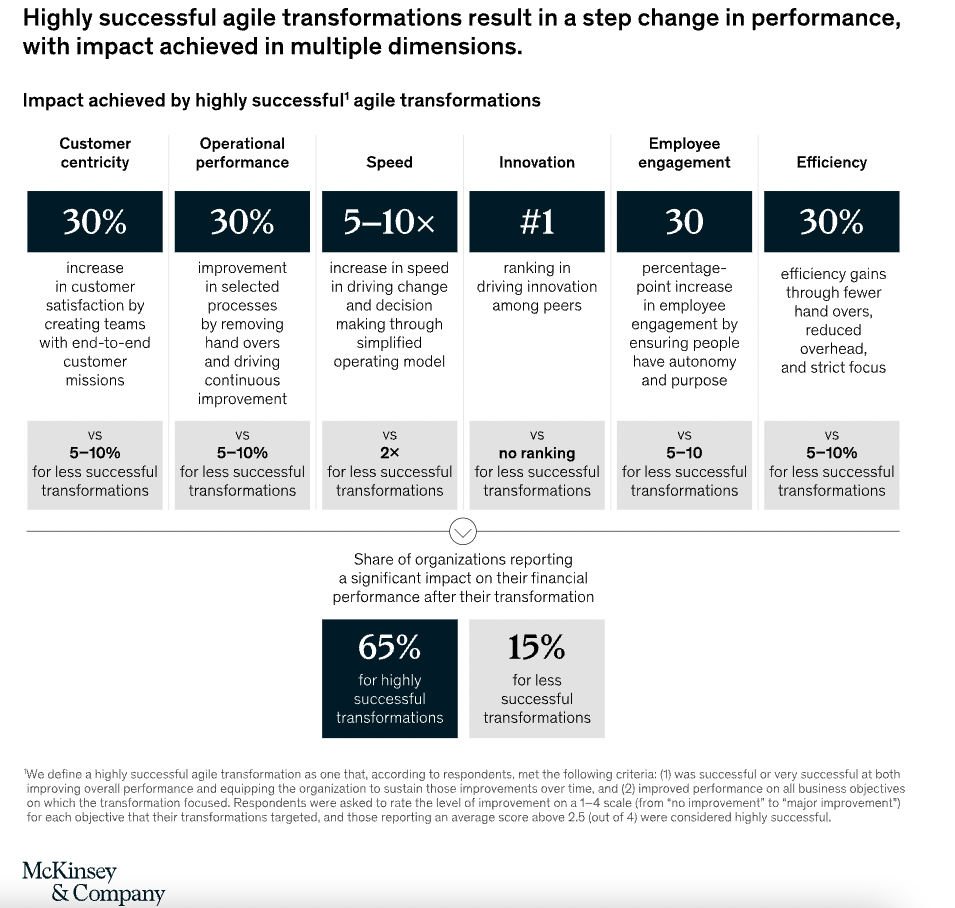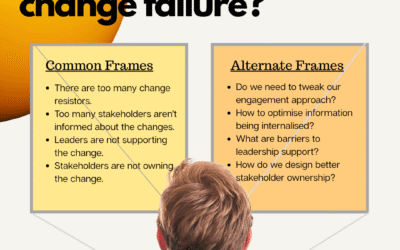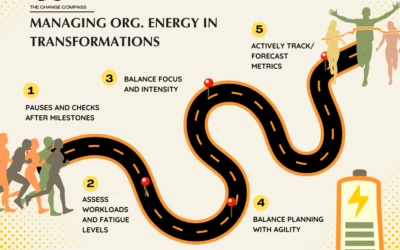It is 2022 and a year ago most of us were praying for the end of Covid so that we can move back to ‘normal’. One year on, here we are again. Covid disruptions are even more severe and widespread. Not only are we still amidst continuous business disruptions compared to a year ago, but probably even more severe.
We see lots of memes around social media of people wanting to forget the past year with the difficulty of life caused by Covid. And a year ago it was the same. What we are learning is that change and disruption will not be going away any time soon. The only thing we can do to support our organisations is to continue to build change agility. With better change agility, organizations are better able to respond to constant and continuous change.
The big positive for change managers is more than ever, change is now the centre of attention for businesses. In the past, many would struggle to position management conversations about the importance of managing and leading change. That is no longer the case. Even the most backward and change immature businesses are thrust into the midst of constant change. We no longer need to raise this as a topic of focus.
This means now is the opportune time to utilise the focus on change to gear up the organisation’s readiness and capability to respond to the constant change in the longer term. More than ever now is the time to pitch to your organisation about the importance of building the right ‘change agility muscles’ so that the organisations can remain competitive and in business.
What are the benefits of agile organisations?
We can see quite stark examples of organisations that are agile versus those that are not. Businesses that jumped on web offerings have benefited significantly versus those that have relied purely on brick-and-mortar channels. Other businesses have diversified their offering whilst others have reduced their store footprint.
Mckinsey studies have shown that with successful agile transformations, organisations can achieve significant business improvements. Not just surviving, successful companies have achieved 30% better customer satisfaction, 30% improvement in operational performance, 5-10 times speed in driving change and decision making and ranking higher in innovation compared to peers. These organisations are also 30% better at engaging employees and 30% more efficient in their operations through fewer handovers, and reduced overhead with clear focus areas.

However, as a change manager, how can you move the dial on improving your organisation’s agility for change? As a solitary individual how does one person influence an organisation? This is especially when you may not have the decision-making authority or the power? As a change manager, you have your project work defined. How can you do this without boiling the ocean which may not be part of your bread-and-butter role?
These are 5 ways to improve your organisation’s agility as a change manager:
1. Influence your project sponsor and business owner to lead agility.
A part of the change manager’s role is to help influence and equip stakeholders with the right skills to drive the change. This starts with your own project. As a project, assess the skills of your project sponsor and business owner. Do they have the experience and skills to lead agility practices as a part of overall change leadership?
These may include:
- Ability to spot changing and emerging trends that may impact the organisation’s business
- Balance the oversight of immediate daily operational trends and insights, against longer-term and more strategic patterns and trends that may emerge
- Ability to work across disciplines in influencing change
- Promotion and advocacy of constant experimentation and testing of new ideas and concepts, supporting experimental failures as they arise
- Lead behaviours that support organisational learning, whether it’s learning from within the industry outside the industry, using historical data, or through innovation incubation teams
- Savviness with shifting technological trends and use cases that could implicate the business
Work with your sponsor and business owner and help to identify key required agility leadership behaviours. Partner with them and coach as necessary to support these behaviours. Collaborate and come up with a skills development plan if necessary.

2. Embed agility practices within the implementation of your project.
To support business agility the first step from a project perspective is to ask how the project benefits can be protected and sustained even in times of constant disruption and uncertainty. Asking this question is the first step to take. Simply asking this may help you re-shape the project’s approach in its implementation and the work involved.
Some of the ways in which you can design agility into your project include:
- Designing flexible role and team structures where appropriate to ensure that any workload or role changes can be easily flexed and catered for in case of future changes
- Designing the right skills and competency requirements into business roles as a part of role requirements, including agile leadership, experimentation, work approach flexibility, and reporting/data fluency
- Building agile business rhythms and routines into business readiness and future end-state designs. These may include stand-ups, business scanning and review practices, and agile iteration practices
- Work closely with your business representatives and subject matter experts within your project and leverage them as anchors for agility practices into the business
- Leverage your pilots as agility experiments in designing agility components into your change implementation. For example, use the pilot as a test from which to build agility components so as to further change agility in the rest of the project roll out
3. Proactively participate in the change centre of excellence, or if this does not exist, build a change network with other change managers and interested business representatives
Leverage the power of other change practitioners in other projects and across the business to collaborate and build a common approach to further change agility in the business. Work with others to come up with ways to influence the business and build practices that will help the business strive in times of disruption and change. Don’t underestimate the power of like-minded representatives across the business. Each representative acts as an influencing node from which powerful tactics and practices can be driven into the business.
Work across projects to build one view of change impacts. By building this integrated view of change impacts across multiple projects, you are also helping the business connect the dots and build an integrated way of getting ready for all changes, not just yours. An integrated view of change can help you:
- See a holistic picture of what is going to change
- Prepare the business for what is going to change across the board, and this is made easier by knowing what will be changing
- Utilise the changes in the roadmap to design a series of agility tests to prepare the business for challenges further down the track in the roadmap

4. Liberalising data and support swift decision making
Historically, in hierarchical companies data is usually restricted to select managers. With digitisation there is an opportunity to give power to a much larger number of employees to access data and through this be more aware of the changing needs of the company. Liberalising data to make faster and better decisions is one of the key trends of digitisation. This is also a key enabler for change agility. With easier data access for a greater number of employees, decisions can be made by those who are most familiar with the work context, in a timely fashion. This ease of data access means that someone does not need to wait for rounds of approvals to make decisions.
This also applies to change data. Rather than restricting the access of change impact data to a select few managers, liberalising this across a larger number of managers and team leaders can help to paint a clearer picture of change and help equip the business’ readiness for change.
The ease of acess to data does not just mean the raw data itself, but ease also implies the ease of understanding the format of the data. Pre-configured data visualisation and charts are valuable since the user will not need to go through long training sessions in order to use the data. By making the data easily understood and make sense, the business can then balance forecasted change against impending change disruptions that may not be forecasted.

5. Conduct change scenario planning
Scenario planning is an exercise where a facilitated team reviews the existing operations and the external business environment to try and forecast differing business scenarios. Scenarios are then used to build the right tracking signals. The business may have already built safeguards toward this scenario, or a clear set of next steps in which to deal with the progress toward this scenario.
Not a lot of projects conduct scenario planning, as scenario planning is typically conducted by strategy and planning functions. However, undertaking scenario planning can help build in the right rail guards to safeguard against different scenarios before they emerge.
Work with your project team and business stakeholders to undergo an annual scenario planning exercise in which to prepare the business for various environmental disruptions and challenges. Scenario planning does not need to be a long, formal, drawn-out process. It could be as simple as spending a day exploring what the future holds, having done the homework to prepare for what the data could be telling us. After identifying various scenarios, ensure you name each scenario, with a meaningful analogy if needed so that it’s more meaningful and easier to remember for the team.
You can also put in practice scenario planning on a smaller scale. Within certain junctures of the project, you can build in mini-scenarios of the various change outcomes that may occur, and build in the right tracking metrics and reporting to see which scenario is emerging.
You can also use scenario planning to work through multiple changes across the projects and change landscape. Use similar concepts to work-through options in sequencing and prioritisation and what this means to change implementation timelines and tactics. For example, are there ways in which implementation may be combined across projects? Or can releases be broken down into smaller change bites to aid adoption and cater to limited business capacity?
There are many ways in which you as a singular change manager can influence and drive significant agility changes within your organisation. Here we outline 5 major ways in which you can do this. Since disruption and ongoing change are not going away, this is the opportune time for change practitioners to grab this window of opportunity and work with the business to develop and design change agile organisations. Not only will your project have a significantly better chance of realising its targeted benefits, but so will other projects in the pipeline.
To read up more about agile check out this artcle – The Ultimate Guide to Agile for Change Managers






